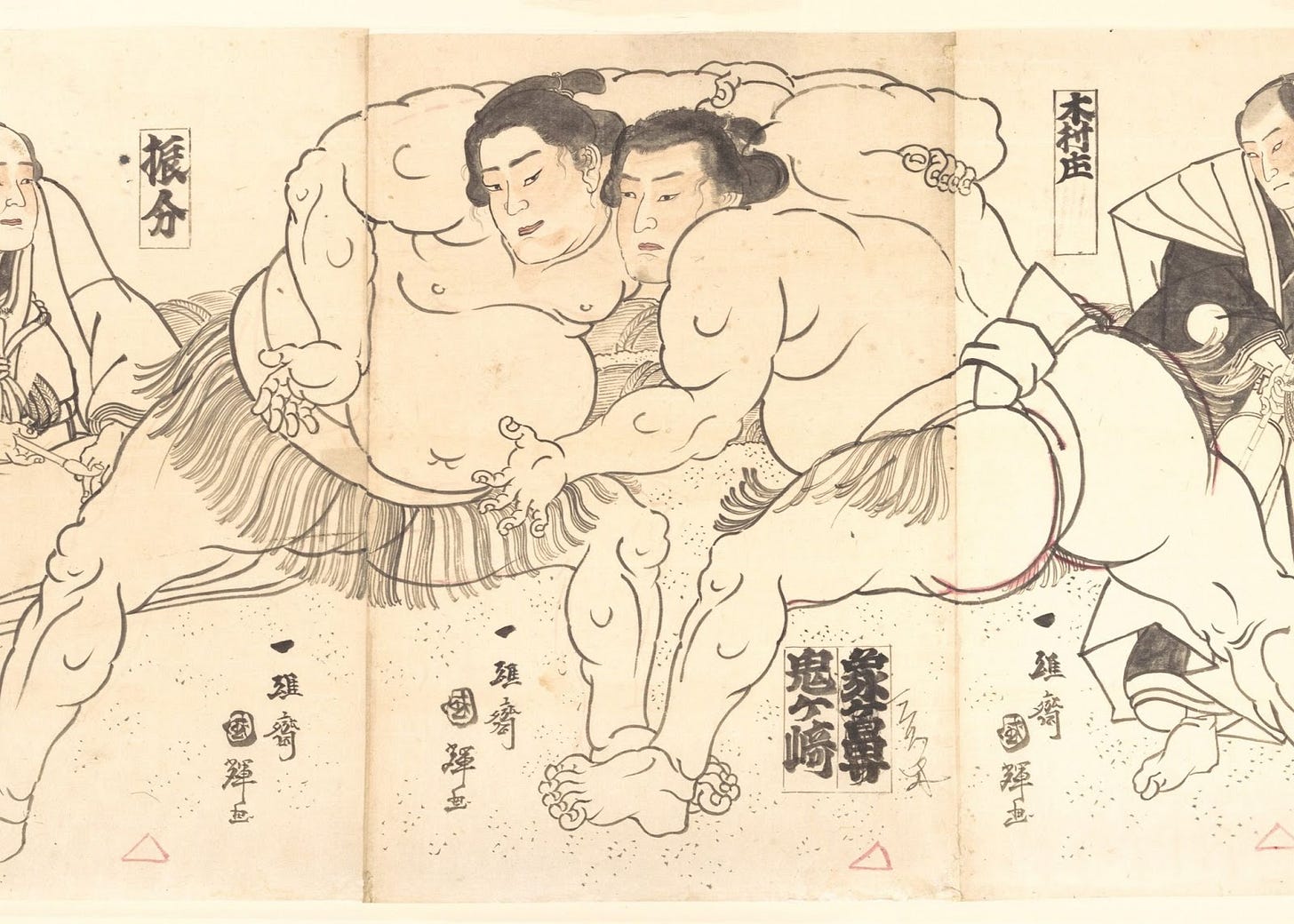The Legendary Origins of Sumo Wrestling
When you see two men shaped like Totoro and Snorlax dressed in loincloths bump into each other you may find yourself wondering: how did it get to be this way? The two oldest literary works of Japan, the Kojiki (completed 712 AD) and the Nihon Shoki (completed 720 AD), are no help whatsoever, but they do contain some cool propaganda.
During the 500s and 600s Yamato province had been in a power struggle with Izumo province. By the early 700s the Yamato were the clear winners, but they still felt the need to tell lots of cool stories about how much better they were than the Izumo.
The first legend is about a fight between the gods. The Kojiki tells us about a time when the gods of heaven and the gods of the land were divided. Some gods, like the sun goddess Amaterasu, ruled over heaven, while others lived in “The Middle Land Where Reeds Grow Luxuriantly.” This name proved unwieldy, so today we call this place “Japan.”
One day, Amaterasu sent the god of thunder Takemizuchi down to take control of the reedy lands she coveted. Takemizuchi landed in Izumo province, and quickly convinced its ruler Ōkuninushi to submit. However, one of Ōkuninushi’s sons, Takeminakata, refused.
Takemikazuchi and Takeminakata wrestled. When Takeminakata tried to grab Takemikazuchi’s arm, it turned into an icicle, so Takeminakata quickly let go. He tried again, but this time Takemikazuchi’s arm turned into a sword, so he let go once more. When Takemikazuchi grabbed Takeminakata’s arm in return, he crushed it like a reed.
Takeminakata begged for mercy and pledged eternal loyalty to Amaterasu and the other heavenly kami. One of the claims of the Yamato was that they descended from the sun goddess Amaterasu, so this was a clear Yamato W.
The second origin story is about the dangers of being way too conceited. In the Nihon Shoki, the Yamato Emperor Suinin heard about a certain Taima no Kehaya, who could break the horns of cattle and straighten out iron hooks.
Kehaya was apparently unaware of what happens to boastful people in stories of this kind and said foolish things like “I am the strongest under heaven” and “You may search the four quarters, but shall never find one to compare with me in strength. O that I could meet with a man of might, with whom to have a trial of strength, regardless of life or death.”
Emperor Suinin questioned his ministers about possible challengers. The ministers had nothing better to do than check up on strong dudes, because one of them immediately replied that in Izumo province there lived a strong and valiant man called Nomi no Sukune.
The Emperor summoned both men and had them fight. Sukune kicked Kehaya, killing him by breaking his ribs and back. The Emperor, citing a lack of medals due to their not being invented yet, seized Kehaya’s land and gave it to Sukune as reward. Sukune remained at the Yamato court, serving the Emperor. So this time the Izumo representative won the fight, but willingly submitted to the Yamato—the ultimate Yamato flex.
Despite kicking being forbidden in modern sumo, Sukune is considered the father of sumo, and the Nomi no Sukune shrine in Tokyo is maintained by the Japan Sumo Association to this day. (For the record, turning your arm into an icicle is not explicitly forbidden in modern sumo, so Takemikazuchi has at least as good a claim as Sukune on the title of father of sumo!)
Hey did you know you can get members-only videos on my Patreon? Check out the latest one, a Japanese folktale about a mysterious wife and a husband who’s not about to win a Husband of the Year award any time soon:
Take a look at the other videos too! There are uncensored videos that cannot be shown on YouTube 😳



Yes! I love sumo wrestling and I've been hoping for a long time that you would do an article or video about it. It's such a fascinating part of Japanese culture, along with being an exciting and entertaining sport. Thank you for this!